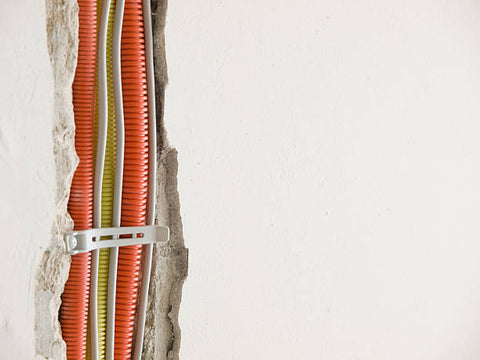What Size Conduit for 10/3 Wire?
For 10/3 wire, which is typically used for 30-amp circuits, you may opt for 1/2-inch or 3/4-inch conduit, with the latter being a safer choice if you have bends in the conduit run or if you plan on running more than one cable through.
- If you are using Electrical Metallic Tubing (EMT), a 1/2-inch conduit could be sufficient for one 10/3 cable, but if you're running more than one cable or if there are several bends, you might need to size up.
- For PVC or Rigid Metal Conduit, you would use a similar sizing approach, but always check the fill capacity and what the local code allows.

Should I Use 10/3 UF-B or 10/3 NM-B in Conduit?
The short answer to this question is that sometimes you can, but individual THHN/THWN wires in conduit are always a better alternative. Plus, they are cheaper.
10/3 NM-B and UF-B cables are often run in conduits for physical protection. However, many people would reasonably advise against running 10/3 NM-B and UF-B cables in conduit because of their size, rigidity, and the potential risk of damage. UF-B is a flat and rigid cable, and there are good reasons why it is designed for direct burial. As a general rule, NM-B is not meant for conduits as it is an interior cable, and UF-B can be buried directly, so it does not need a conduit.
Individual THHN/THWN wires are a better option for 10 AWG conduits because they are thinner and more flexible, making pulling through conduits much easier. THWN is more efficient in conduit compared to other cables.
One case when NM-B and UF-B should be placed in conduit is when the cable emerges from a hidden area and runs exposed for some time. For example, this happens when a directly buried UF-B cable emerges from the ground and runs exposed to the side of the outbuilding. Another example is when the NM-B wire should run from the wall to the air conditioning unit.
10/3 Conduit Size Depending on Cable Type
- For 10/3 NM-B or UF-B cable, use at least a 3/4-inch conduit.
- For individual THHN/THWN wires that make up a 10/3 configuration, you can use a 1/2-inch conduit for a single run. However, a 3/4-inch conduit is recommended to make pulling the wires easier, particularly if you have multiple bends. You can put up to 4 wires into a 1/2-inch conduit.
Which Conduit For 10/3 Wire?
The types of conduit most often used for 10/3 wire are EMT and Schedule 40 PVC. EMT (Electrical Metallic Tubing) is mostly for indoor applications and physical protection. The benefit of this conduit is that it is flexible.
Schedule 40 PVC is for outdoor and underground installations. It is designed against corrosion. Most of the time, you don't need Schedule 80 PVC except for underground installations where the cable might be subject to severe damage.
You can purchase 40 PVC and EMT conduits at Nassau National Cable. 10/3 NM-B cable, 10/3 UF-B Cable, and individual 10 AWG THHN wires are also available.

















